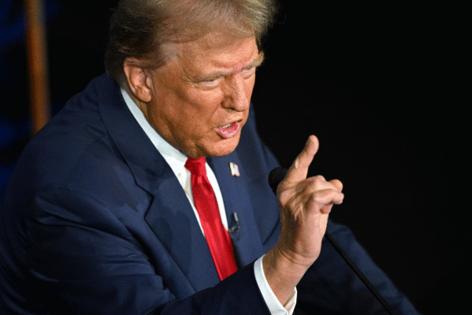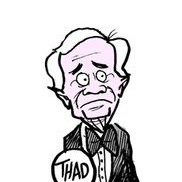Fact check: No evidence Trump's drug program for terminal patients saved 'thousands' of lives
Published in Political News
“Right To Try” experimental drug program saved “thousands and thousands of lives”
Former President Donald Trump on Aug. 30
____
Former President Donald Trump has boasted in recent months about “Right To Try,” a law he signed in 2018. It’s aimed at boosting terminally ill patients’ access to potentially lifesaving medications not yet approved by the Food and Drug Administration.
“We have things to fight off diseases that will not be approved for another five or six years that people that are very sick, terminally ill, should be able to use. But there was no mechanism for doing it,” Trump said Aug. 30, speaking in Washington, D.C., to supporters of the conservative parental rights advocacy group Moms for Liberty.
He also said that because of Right To Try, “we have saved thousands and thousands of lives.”
Trump similarly praised the program during an Aug. 17 rally in Pennsylvania, in a podcast interview with a conservative commentator, and during his Republican National Convention acceptance speech: “Right To Try is a big deal,” Trump said then.
Medical experts who’ve studied the experimental treatment program, however, say there’s no evidence to support Trump’s claims. These experts say Right To Try weakened regulations intended to protect patients.
What Is Right To Try?
The Trickett Wendler, Frank Mongiello, Jordan McLinn, and Matthew Bellina Right To Try Act, aka Right To Try, passed Congress on a bipartisan basis and was signed into law in 2018. It sought to streamline the process for getting potentially lifesaving drugs that weren’t yet FDA-approved to terminally ill patients. The speed matters; industry groups say it takes 10 to 15 years on average for a new medicine to reach pharmacy shelves.
However, a similar FDA program, the expanded access pipeline, sometimes called “compassionate use,” has existed since the 1970s, and became law in 1987.
And that is the root of many criticisms of Right To Try.
“Right To Try is basically ‘expanded access light,’” said Alison Bateman-House, a medical ethicist who researches access to investigational medical products at New York University’s Grossman School of Medicine.
Right To Try caters to fewer patients than expanded access and offers them fewer treatments, Bateman-House said.
Easing Access or Erasing Safeguards?
Patients must meet specific, but different, criteria to qualify for either experimental medication program.
To qualify for expanded use, patients must have a “serious or immediately life-threatening disease or condition” for which there is no “comparable or satisfactory alternative therapy available to diagnose, monitor, or treat the disease or condition,” according to government regulations. Clinical trials must be infeasible for the patients, and the use of these drugs must not interfere with any in-progress studies. Also, the potential benefits must justify the risks, according to the prescribing physicians.
Then, after identifying a treatment, the patient’s doctor must receive approval from its manufacturer, the FDA, and the institutional review board overseeing the medication’s clinical trials.
The FDA said these steps exist so the agency can “fairly weigh the risks and benefits” of the medication and protect the patient’s safety. The agency also collects data about the drugs’ clinical impact on the patient and any adverse effects to inform the wider approval process for the drug.
Right To Try sought to hasten this approval process. Under the new program, for instance, a doctor must merely identify an experimental medication and receive authorization to use it from the manufacturer. In most cases, the FDA has no authority to approve or deny the application, and there’s no review board process to navigate.
But, because of the Right To Try program’s definitions, fewer patients and fewer medicines qualify.
Under Right To Try, patients must have a “life-threatening” disease or condition, not just “serious,” as with expanded access. Experimental medications are available only after they’ve completed Phase 1 clinical trials; treatments accessed through the expanded access program can be administered during a Phase 1 study.
Right To Try, which includes liability protections for manufacturers and prescribing physicians, also weakens requirements that govern how doctors disclose experimental medications’ risks to patients, leaving informed consent undefined. And it prevents the FDA from using information about how patients tolerate the drugs to “delay or adversely affect the review or approval of such drug(s),” unless top officials justify the benefit to public health in writing.
Supporters say Right To Try is an example of successful deregulation and claim that its more efficient approval process saved lives. But critics see this as a key reason for concern, because it “opens up the opportunity of exploiting desperate patients,” said Holly Fernandez Lynch, a bioethicist who studies pharmaceutical policy at the University of Pennsylvania’s Perelman School of Medicine.
Government data shows regulatory agencies weren’t the main hurdle patients faced when seeking experimental drugs. The FDA almost always approved expanded access applications, and quickly by government standards.
According to a 2018 FDA report on the expanded access program, the FDA authorized 99% of the roughly 9,000 requests it received in the previous five years, approving emergency requests for experimental medications in less than one day on average. More recent data shows that approval trend has continued, even as the number of applications has grown each year.
In rare cases in which the FDA didn’t automatically approve requests, regulators often didn’t deny them, but recommended tweaks to the requested dosage to address safety and effectiveness concerns.
Right To Try by the Numbers
The FDA does not share detailed information about the number of doses provided or patients treated under Right To Try. Instead, it posts only an annual summary showing how many drugs have been approved under the program. The agency says that since Right To Try began in 2018 it has approved 16 treatments: 12 from 2018 to 2022 and four last year.
The FDA declined to provide additional information about the number of Right To Try requests or approvals.
Although the 16 medications approved through Right To Try were possibly provided to more than one patient each, experts said it’s extremely unlikely thousands of patients were involved, as Trump said.
Trump’s claim represents an “egregious overestimate of the number of people who are using Right To Try,” said Fernandez Lynch, noting she believes the real numbers are “very, very low.”
The Trump campaign did not respond to multiple inquiries about the source of the former president’s statistics. Karoline Leavitt, the campaign’s national press secretary, told KFF Health News that in a second term “President Trump will of course remain open to other pathways to expand ‘Right to Try’ to save more American lives.”
It remains unclear how Trump might expand the program, though the conservative Goldwater Institute is advocating for “ Right To Try 2.0,” which it claims will let patients receive individualized therapeutics.
Experts noted such drugs are already accessible through the expanded access program.
Meanwhile, evidence shows that the high price of experimental treatments, which are sometimes available through certain drug company programs but not typically covered by insurance, is a greater hurdle to patients than regulatory guardrails are.
“I don’t think that people are having a problem with the FDA blocking access to individualized therapeutics,” Bateman-House said. “I think the problem is that individualized therapeutics are incredibly expensive, and there’s only a very small number of researchers in the country who know how to make them.”
Our Ruling
Trump has claimed throughout the campaign that his Right To Try program is novel and has saved thousands of lives. But a similar program has existed for decades, and there is no evidence Right To Try has had anywhere close to the impact Trump said it has had.
Neither the Trump campaign nor Right To Try advocates provided evidence to back claims of widespread benefit. And government data shows only 16 medications have been approved under the program in its first six years, with no accounting of how many patients used those medications or their clinical outcomes.
Moreover, public health experts have said Right To Try weakens patient protections and fails to address the true barriers to experimental medications.
We rate Trump’s claim False.
©2024 KFF Health News. Distributed by Tribune Content Agency, LLC.




























































Comments